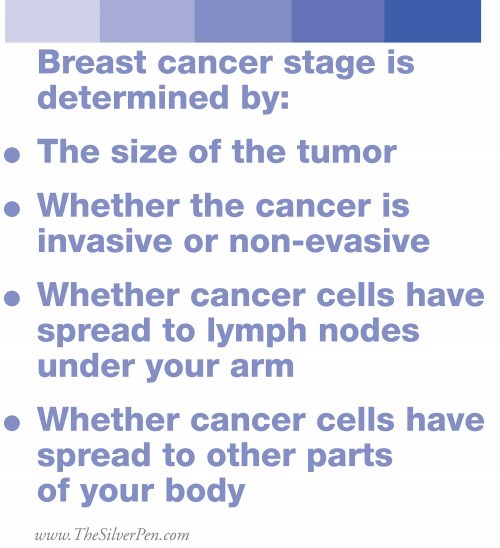Hearing a diagnosis of FBC (f-bomb breast cancer) is an earth shattering and mind blowing experience all wrapped up in a box of disbelief. Less than 5% of what is heard at a diagnosis meeting is retained. It’s all so confusing and overwhelming. Even as a nurse, I shut down, emotionally and cognitively when I heard the words: “You have breast cancer.”
After my diagnosis, the number one question that I was asked was “What Stage are you?” It just occurred to me that it might be helpful to share with you the nuts and bolts of FBC staging (I never did promise that I quick on the uptake!).
Breast cancer staging is the process to determine location, size and type of cancer. It is also identifies whether the cancer has spread within the breast or to other parts of the body. Staging is used to determine treatment and prognosis (a medical opinion on the likely course and outcome of a disease).
Cancer staging also gives everyone a common way to describe the breast cancer, so that treatment results can be compared and understood relative to that of other people. Here is a little diagram (because you know how I love visuals!):
Breast cancer stages range from 0 to IV, with many subcategories. Lower numbers indicate earlier stages of cancer, while higher numbers reflect late-stage cancers:
Stage 0 describes Ductal carcinoma in situ or noninvasive breast cancer where there is no evidence of cancer cells or non-cancerous abnormal cells spreading beyond the breast.
Stage I is an early stage of invasive breast cancer where cancer cells are invading normal surrounding breast tissue.
- Stage IA: The tumor measures up to 2 cm and no lymph nodes are involved.
- Stage IB: Cancer cells that are larger than 0.2 millimeters but not larger than 2 millimeters exist in the lymph nodes with either no tumor in the breast or the tumor is 2 cm or smaller.
Stage II indicates invasive breast cancer cells.
- Stage IIA: The tumor is larger than 2 cm but not larger than 5 cm and has not spread to the lymph nodes OR the tumor is 2 cm or smaller and also found in the lymph nodes OR no tumor is found in the breast but cancer cells are found in the lymph nodes under the arm.
- Stage IIB: The tumor is larger than 2 cm but not larger than 5 cm and cancer cells larger than 0.2 millimeters but not larger than 2 millimeters are found in the lymph nodes OR tumor is larger than 2 cm but not larger than 5 cm and cancer cells have spread to 1-3 lymph nodes under the arm or near the breastbone OR the tumor is larger than 5 cm and has not spread to lymph nodes. (This is where I landed on the trajectory.)
Stage III indicates an invasive stage of cancer that has not spread to distant body organs.
- Stage IIIA: The tumor is larger than 5 cm and the cancer has spread to 1-3 lymph nodes under the arm or near the breastbone OR the tumor is larger than 5 cm and small clusters of cancer cells larger than 0.2 millimeters but not larger than 2 millimeters are found in the lymph nodes OR no tumor is found in the breast or it may be any size and cancer is found in 4-9 lymph nodes under the arm or near the breastbone.
- Stage IIIB: The tumor may be any size and cancer cells have spread to the chest wall and/or skin of the breast and possibly the lymph nodes within the breast, under the arm or near the breastbone.
- Stage IIIC: No tumor is found or the tumor may be any size and the cancer cells may have spread to the chest wall and/or skin of the breast AND/OR spread to 10 or more lymph nodes under the arm AND/OR lymph nodes above or below the collarbone and near the neck.
Stage IV describes invasive breast cancer that has spread outside of the breast and lymph nodes to distant parts of the body such as the bones, lungs, liver, or brain.
The Silver Lining of hearing “You have breast cancer” is knowledge. Knowledge really is empowering. Cognitive understanding of what you’re dealing with demystifies the emotional experience and that really does make all the difference in the world as you embark on the long, pothole filled road that is FBC treatment. What I know for sure is that: We. Can. Do. This.
Please know that The Silver Pen community is indeed here for you.



Hi Hollye,
I had always thought you were diagnosed with stage 2b & not 3b, as stated above. Could you please clarify this for me?! Thank you so much,
Kim
Dear Kim,
THANK YOU as always for being ever so thoughtful. You are exactly correct: I was 2b. I finished the post yesterday and last night thought "I didn't add my stage." Clearly I did it past my bedtime. Thank you so much!
Good News Hollye! Nice nuts and bolts:)
Kim
Thanks so much, Kim!
I am waiting for a mammogram scheduled for December 16, I have a 7cm mass above my right breast, 2cm in my underarm and one approximately 5 cm in my breast. My mother fought a valiant battle and lived for about ten years after her diagnoses. She was 45 when she discovered the lump. I am 53, I thought I was safe as the years drifted by. We had completely different lifestyles, diets, relationships. I am so afraid.
Dear Rhonda,
Thank you so much for sharing. I'm so sorry to hear that you are afraid. Please know that you are not alone….and that I am sending all of my very best wishes to you. I hope that you will stay in touch and know that I'm thinking about you.
Warmly,
Hollye